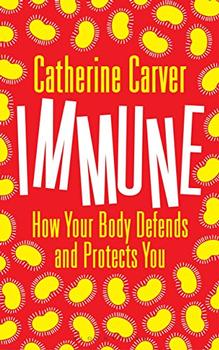Summary | Excerpt | Reviews | Beyond the Book | Readalikes | Genres & Themes | Author Bio

 Book Reviewed by:
Book Reviewed by:
Natalie Vaynberg
Buy This Book
Returning to the plot, the reason we make skin-based sofas is that it's pretty hardwearing stuff. The skin on the soles of your feet is eight times thicker than the skin on your eyelids, but every inch of it is an exquisite barrier that keeps unwanted invaders out. Key to this barrier is the outermost layer, called the epidermis. When we shed skin, it takes the skin cells two to four weeks to migrate through the four layers of epidermis, changing their appearance and function like tiny chameleons as they migrate from the deepest layer up to the surface. The bottom layer is only one cell thick, and it's usually the only point in the epidermis where the cells are capable of dividing – from here on up they're on a one-way journey to death.
The first step on our tiny chameleons' lethal journey involves changing their structure to become the prickle cell layer. It gets its name from the fact that if you look at the cells under a microscope at this stage it seems like they're connected to each other by lots of spines or prickles. The spines are actually keratin fibres and connection points called desmosomes which anchor the cells tightly together to create a relatively impenetrable wall 8 – 10 cells thick.
As the cells move from this sheet into the granule cell layer above, they begin to lose their nuclei and instead become packed with fat. At the border between this layer and the one above, the cells unleash their fatty payload to waterproof the skin. In a recent quest to understand this waterproofing, scientists from Sweden shaved a sliver of skin from the arms of five volunteers. They then froze the tissue by putting it in a high-pressure freezer at -140 ° C (-220 ° F) to capture the exact atomic arrangement in that moment. They then took that Kodak moment and using a chilled diamond blade they sliced the skin into superfine slices and used a microscope cooled to -180 ° C (-292 ° F) to look at the structure of the fat layer. What they found was quite unexpected; the arrangement of the fat molecules was unlike anything they'd seen before. Fat molecules usually look a bit like hairpins, with a head and two tails that point in the same direction. However the fat molecules in the frozen skin had tails pointing in opposite directions, as if you took the hairpin and pulled the tails apart to create an almost flat structure. These flattened-hairpin fats stack much more densely than a normal fat layer, creating an even better barrier.
We end at the final resting place of the now dead skin cells: the stratum corneum. The cells here have become flattened stacks of keratin scales, which you slough off and rain down at a rate of roughly 50,000 cells a minute. Now think about the fact that we're all shedding like that, and it's almost unsurprising that dead skin accounts for about a billion tonnes of dust in the atmosphere. Unsurprising, but gross. On the plus side, this constant turnover of cells at the sloughing surface means the barrier is continually replenished and rejuvenated, keeping our skin healthy and keeping the billions of bacteria slathered over its surface out.
Lungs, guts and an accidental shooting
Unfortunately, we can't be truly impenetrable. We need to let in food and water and air and light, and we need to let some things out too. So we have a body full of holes, which is deeply inconvenient from a security perspective. But we have clever holes. Take your mouth: every time you inhale you are sucking about 10,000 bacteria into your lungs. Thankfully your airways are exceedingly well booby-trapped passages lined with goblet cells, which secrete a fine layer of mucus to trap dirt and bacteria. The dirty mucus is then escorted out by microscopic whip-like structures called cilia that stick out from the lining of the airways and beat 1,000 – 1,500 times per minute, forcing the mucus up and out of the lungs in waves at a rate of 2 – 3cm/min (~1in/min). Cigarette smoke disables this defence, by slowing, then paralysing and finally killing off the cilia. Smokers are thus left with a lung full of dirty mucus and their body must resort to a less refined method of ejection – the smoker's cough.
Excerpted from Immune by Catherine Carver. Copyright © 2017 by Catherine Carver. Excerpted by permission of Bloomsbury USA. All rights reserved. No part of this excerpt may be reproduced or reprinted without permission in writing from the publisher.





The Funeral Cryer by Wenyan Lu
Debut novelist Wenyan Lu brings us this witty yet profound story about one woman's midlife reawakening in contemporary rural China.
Your guide toexceptional books
BookBrowse seeks out and recommends the best in contemporary fiction and nonfiction—books that not only engage and entertain but also deepen our understanding of ourselves and the world around us.